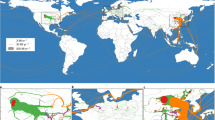Abstract
According to the National Research Council’s Committee on Earth Resources the stated goal of the “sustainability” paradigm is that the economic activity that maintains current well-being not make future generations worse off, either through environmental degradation or resource depletion. Coal is not “running out” in the United States but the effects of economic deregulation of electricity generation, new air quality standards (Phase II of the 1990 Clear Air Act Amendments), and continued restructuring of the coal mining industry will likely stretch lowsulfur coal supplies in the next decade. The paper discusses these forces and then presents summary coal quality data in the form of grade-cumulative tonnage relationships for major U.S. producing areas to show where future low-sulfur coal supplies are likely to come from. The final section considers the potential magnitude of additional demand for low-sulfur coal, alternative compliance strategies, and implications in terms of maintaining economic efficiency and in terms of the “sustainability paradigm.”
Similar content being viewed by others
References
Averch, H. and Johnson, L. L., 1962, Behavior of the firm under regulatory constraint: American Economic Review, December, p. 1052–1069.
Barsotti, A. F. and Kalyoncu, R., 1995, Implications of flue gas desulfurization on the mineral industries: Proceedings of the 4th International Conference on FDG and Other Synthetic Gypsum, May 17–18, 1995, Toronto, p. 4.1–4.32.
Baruya, Paul and McConville, Alessancdra, 1997, Coal sulfur content—impact on coal markets: IEAPER/32, London, UK, IEA Coal Research, 49 pp.
Blumenfield, Andrew, 1997, What to expect from Arch Coal, Inc.: Coal Age (May), p. 49–50.
Bromley, D. W., 1998, Searching for sustainability: the poverty of spontaneous order: Ecological Economics, v. 24, no. 2/3, p. 231–240.
Boyd, G. A., 1987, Factor intensity and site geology as determinants of returns to scale in coal mining: Review of Economics and Statistics, v. 69, p. 18–23.
Charles River Associates, 1977, Coal price formation: Electric Power Research Institute Report EA-497, 193 p.
Coal Age, 1998a, Kerr-McGee to exit coal business, March, p. 10.
Coal Age, 1998b, Arch acquires Arco’s U. S. coal interests, April, p. 17.
Darmstadter, J., 1997, Productivity changes in the U. S. coal mining: Discussion paper, July: Washington D.C., Resources for the Future, 55 p.
Ellerman, D. A., 1996. Price and productivity change in the American coal industry: Presented at the NEMS/Annual Energy Outlook Conference, Arlington, VA, March 25, 1996.
Energy Information Administration (EIA), 1998, The restructuring of the electric power industry: A capsule of Issues and Events, Energy Information Administration, Department of Energy, Washington, D.C., 22 p.
Energy Information Administration, 1997a, The effects of Title IV of the Clean Air Act Amendments of 1990 on electric utilities: an update: Energy Information Administration, DOE/EIA0582(97), 118 p.
Energy Information Administration, 1997b, Coal Industry Annual 1996: Energy Information Administration, DOE/EIA0584(96), 25 p.
Energy Information Administration, 1996, The changing structure of the electric power industry: an update: Energy Information Administration, DOE/EIA-0562(96), 182 p.
Jameison, Dale, 1998, Sustainability and beyond: Ecological Economics, v. 24, no. 2/3, p. 183–192.
Joskow, P. L., 1997, Restructuring, competition, and regulatory reform in the U.S. electricity sector: Economic Perspectives, v. 11, no. 3., p. 119–138.
Keystone Coal Manual Industry Manual, for years 1981, 1986, 1992: McGraw Hill, New York.
Mikesell, R. F., 1994, Sustainability, development, and mineral resources: Resources Policy, v. 20., no 2., p. 83–86.
National Research Council, Committee on Earth Resources, 1996, Mineral resources and sustainability: challengers for earth scientist: Washington D.C., National Academy Press, 26 p.
Platt, J., 1992, Eastern low-sulfur coal supply—A national concern,in Platt, J., Price, J., Miller, M., and Suboleski, S., eds. One point tow—new perspectives on central Appalachian lowsulfur coal supplies: Fairfax, Virginia, Coal Decisions Forum, Tech Books, p. 1–28.
Price, J. P., 1992, Central Appalachian low-sulfur coal availability: uncertainties and implications,in Platt, J., Price, J., Miller, M., and Suboleski, S., eds., One point tow—new perspectives on central Appalachian low-sulfur coal supplies: Fairfax, Virginia, Coal Decisions Forum, Tech Books, p. 29–38.
Scherer, F. M., 1971, Industrial market structure and economic performance: Chicago, Rand McNally, 576 p.
Solow, Robert, 1993, An almost practical step towards sustainability: Resources Policy v. 19, no. 3, p. 162–172.
Tietenberg, T., 1988, Environmental and natural resource economics, 2nd edn.: Glenview, IL, Scott, Foresman, 557 p.
Author information
Authors and Affiliations
Rights and permissions
About this article
Cite this article
Attanasi, E.D. Coal resources, new air quality standards,and sustainability. Nat Resour Res 7, 271–279 (1998). https://doi.org/10.1007/BF02764352
Received:
Accepted:
Issue Date:
DOI: https://doi.org/10.1007/BF02764352




